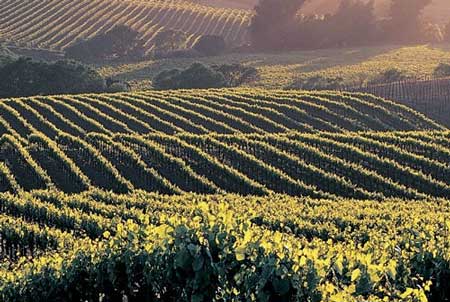VintageTexas Sunday ‘Cyclopedia of Wine: Appellation of Origin/American Viticultural Area
When a winery in the United States wants to tell you the geographic pedigree of its wine, it uses a reference on its label called an Appellation of Origin. Appellations are defined either by political boundaries, such as the name of a county or state, or by federally-recognized growing regions called American Viticultural Areas (AVAs). Click here for a complete listing of AVAs searchable by state, size and other statistics.
Texas has eight AVAs:
Texas Davis Mountains (270,000 acres; effective date 5/11/1998)
Texas High Plains (8,000,000 acres; effective date 4/1/1993)
Texas Hill Country (9,600,000; effective date 12/30/1991)
Mesilla Valley (284,800 acres; effective date 3/18/1985)
Fredericksburg in the Texas Hill Country (70,400 acres; effective date 1/23/1989)
Escondido Valley (32,000 acres; effective date 6/15/1992)
Bell Mountain (3,200 acres; effective date 11/10/1986
Texoma (2,336,000; effective date 1/6/2006).
Three of Texas’s AVAs are in the group of the 20 largest AVA’s. They are Texas Hill Country, Texas High Plains and Texoma.
AVA’s are administered by Alcohol and Tobacco Tax and Trade Bureau (TTB), the newest bureau under the Department of the Treasury. They define AVAs has delimited grape growing areas with distinguishable features, the boundary of which has been approved and established by TTB at 27 CFR Part 9 of the Code of Federal Regulations (CFR). TTB designates AVAs, to allow vintners to better describe the origin of their wines and to allow consumers to better identify wines they may purchase.
Any interested individual or group may petition for a new or modified AVA through the process outlined in, 27 CFR Part 9. The main AVA petitioning elements include substantive documentation and evidence for the name usage, boundary line chosen, distinguishing features of the area, and a written boundary description with accompanying USGS maps.
The Ed Hellman and his viticultural team at Texas Agrilife created and maintain the Texas Winegrape Network, an online archive and database of information related to Texas grape growing, winemaking, research and news. On this site, they have develop an extensive archive of information on Texas’s AVA Wine growing regions at http://txwineregions.tamu.edu.
An example of the information available is the technical summary shown below for the Texas High Plains AVA:
The Texas High Plains is the second largest AVA in Texas, comprising roughly 8 million acres in west Texas, mostly south of the Panhandle region. As the name indicates, this AVA lies within the High Plains sub region of the Great Plains in the central United States. The eastern border of the Texas High Plains AVA follows the 3,000 ft elevation contour line along the Caprock Escarpment, the steep transitional zone separating the High Plains from the lower plains to the east. Elevation within the Texas High Plains gradually increases from 3,000 ft (914 m) at the edge of the Caprock Escarpment to about 4,100 ft (1260 m) in the northwest portion of the AVA. Grapes and wine have been produced in this region since the mid-1970’s and vineyards here have become a major grape supplier to wineries throughout the state.
For more information on Texas High Plains soils and climate, go to: http://txwineregions.tamu.edu/highplains_tech.htm



Be the first to comment